July 28, 2019
- The results of water analysis surrounding nickel mining sites and the nickel processing plants in Rio Tuba and Taganito in the rainy season 2018 and dry season 2019 (Written by FoE Japan in July 2019)
Friends of the Earth (FoE) Japan, with the cooperation of a Japanese citizen’s expert, has been continuously analyzing the water quality in the areas of the Nickel Processing Plant Projects and the Nickel Mining Projects since 2009. This investigation has entered the 11th year. It has been found that hexavalent chromium or Cr (VI) detected in the rivers and the springs have exceeded the Japanese Environmental Standards (0.05 mg/L or less) around Taganito, Claver, Surigao del Norte as well as Rio Tuba, Bataraza, Palawan. Especially, serious pollution by Cr(Ⅵ)was detected in water from the springs which residents living nearby use for everyday life in Taganito. The results here were twelve times higher than the standards (approximate 0.6 mg/L) for the last 11 years as far as FoE Japan analyzed.
Cr (VI) is known as high toxicity due to carcinogenicity, liver damage, and skin disease etc. From the viewpoint of preventing long-term health damage and ensuring the security and life of the local people in the future, the project companies must establish and implement any immediate and effective anti-pollution measures. In addition, the Japanese companies and public agencies concerned are required to ensure the compliance of the same level of Japanese standards, so that they don’t export the pollution with “double standards” under the weak governance or regulation of the local government.
Map: Japan-involved Nickel Projects in Palawan and Surigao del Norte

Table 1: Japan-involved Nickel Projects in Palawan and Surigao del Norte
| Place | Bataraza, Palawan | Claver, Surigao del Norte | |
|---|---|---|---|
| Mining Development | Project Operator | Rio Tuba Nickel Mining Co. (RTNMC) (Nickel Asia Corp.(NAC*)60%、PACIFIC METALS CO.,LTD.[PAMCO] 36%、Sojitz 4%) |
Taganito Mining Co. (NAC* 65%、PAMCO 33.5%、Sojitz 1.5%) |
| Start of Operation | 1975 | 1987 | |
| Mining Permission | 990 ha (Until 2023) | 4,682.75 ha (Until 2034) | |
| Processing Plant | Project Operator | Coral Bay Nickel Co. (Sumitomo Metal Mining [SMM] 54%、MITSUI & CO., LTD. 18%、Sojitz 18%、RTNMC 10%) |
Taganito HPAL Nickel Co. (SMM 75%、NAC* 10%、MITSUI & CO., LTD. 15.0%) |
| Project Cost | 1st plant = around USD 180 million 2nd plant = USD 307 million |
Around USD 1.59 million | |
| Public Agency | 1st plant = Japan Bank for International Cooperation (JBIC) (Loan: USD 70.315 million)/Nippon Export and Investment Insurance (NEXI) (Insurance) 2nd plant = NEXI (Insurance) |
JBIC (Loan: around USD 750 million and around USD 108 millin) NEXI (Insurance) |
|
| Start of Operation | 1st plant = April 2005 2nd plant = June 2009 (Annual Production Capacity: 24,000 tons in total) |
September 2013 (Annual Production Capacity: 30,000 tons) |
*SMM has 26% stake in NAC
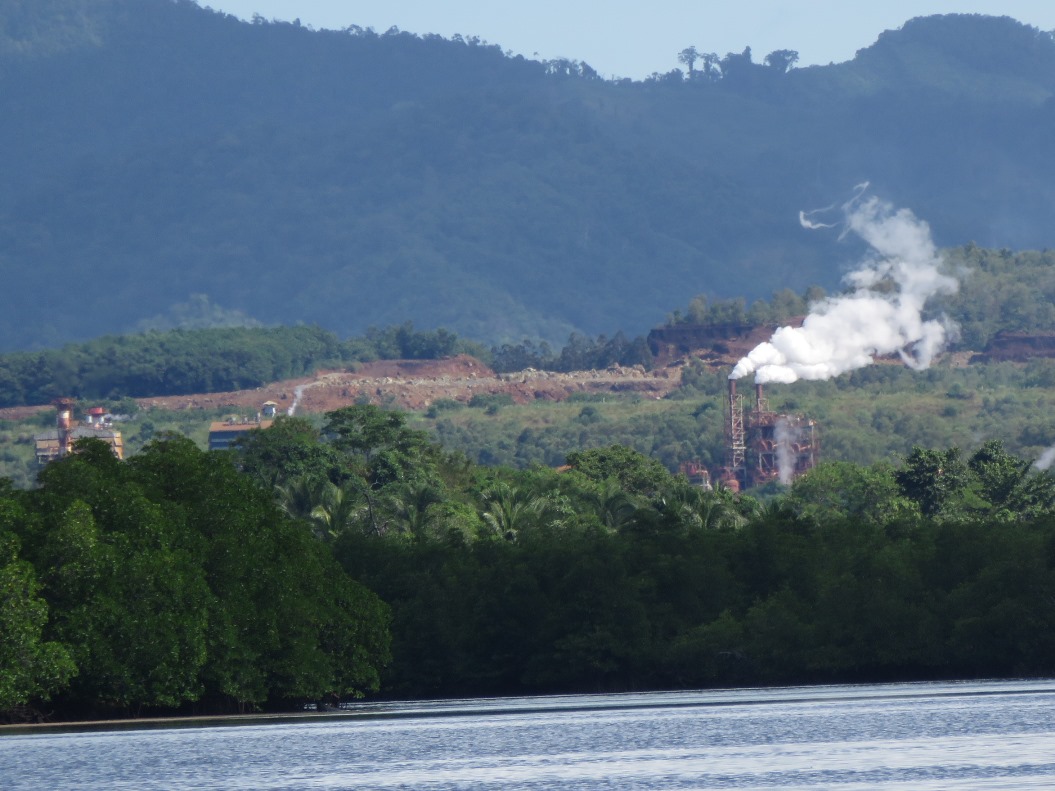
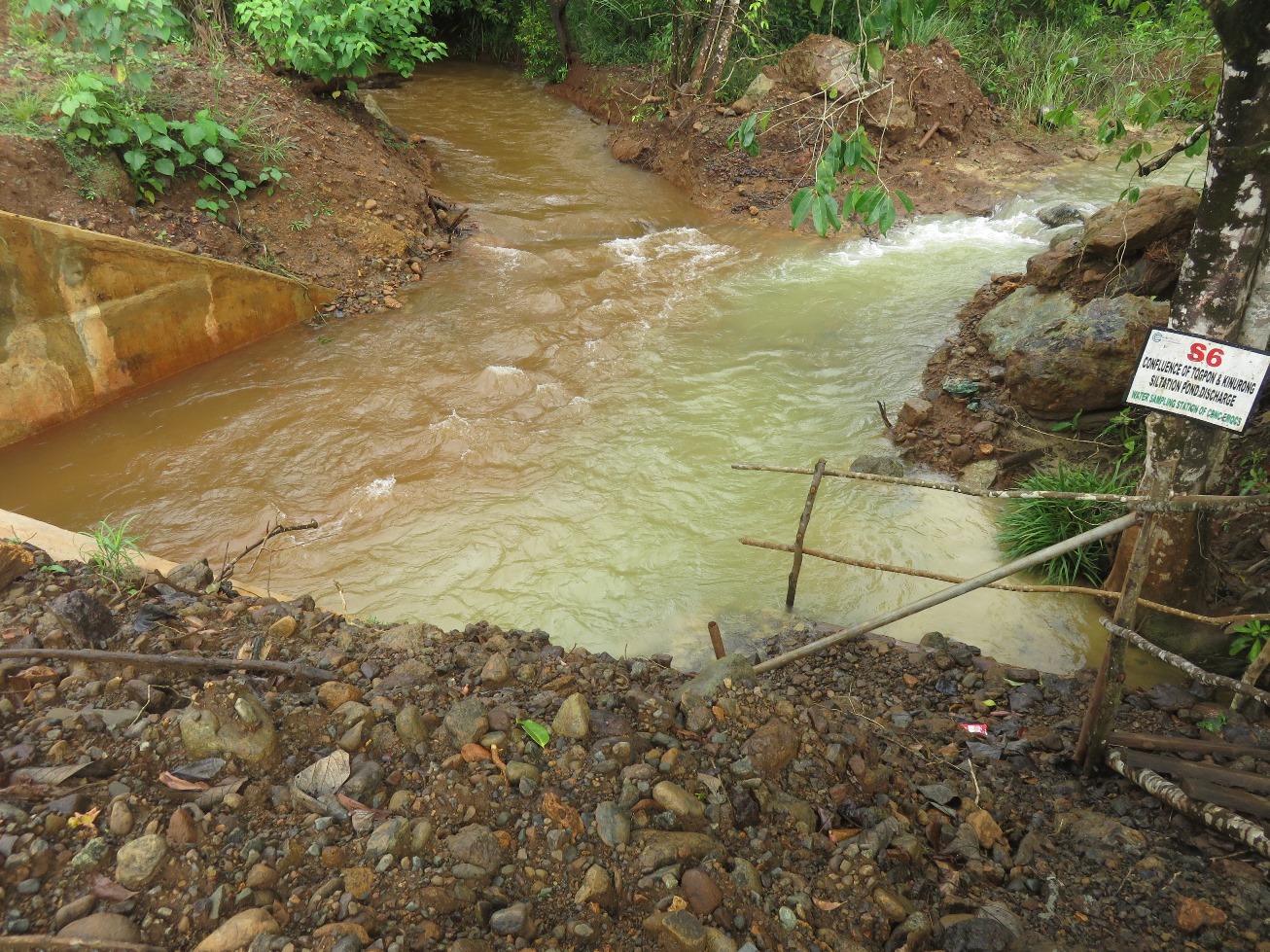
Left Photo: Rio Tuba nickel mining site and Coral Bay nickel processing plants (September 2017)
Right Photo: Togpon River coming from Rio Tuba mining area (October 2016)
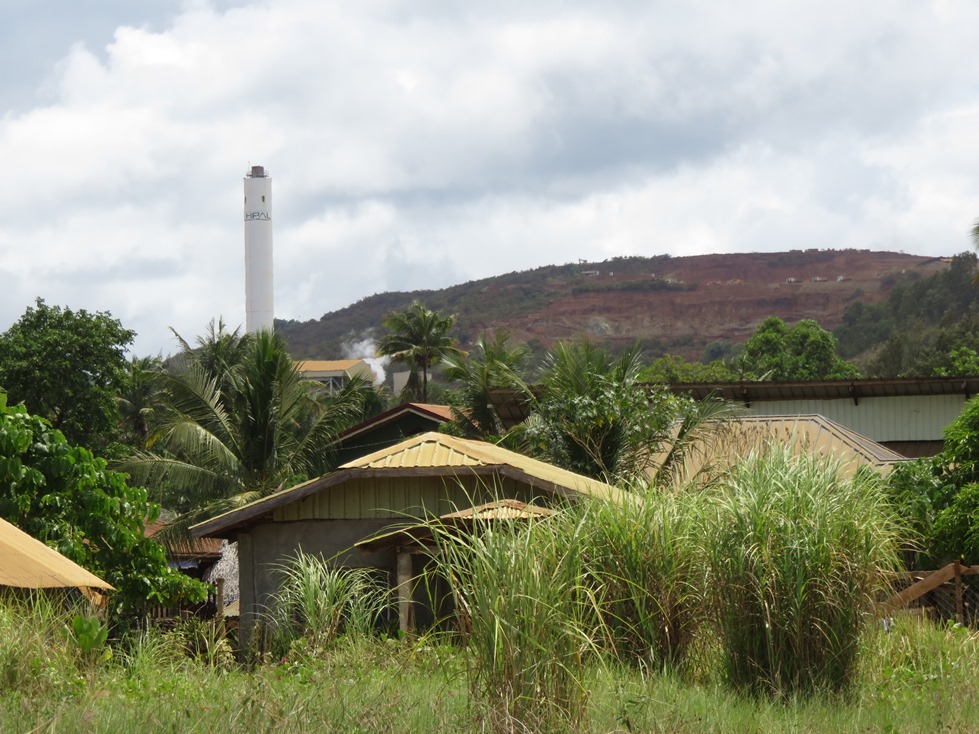
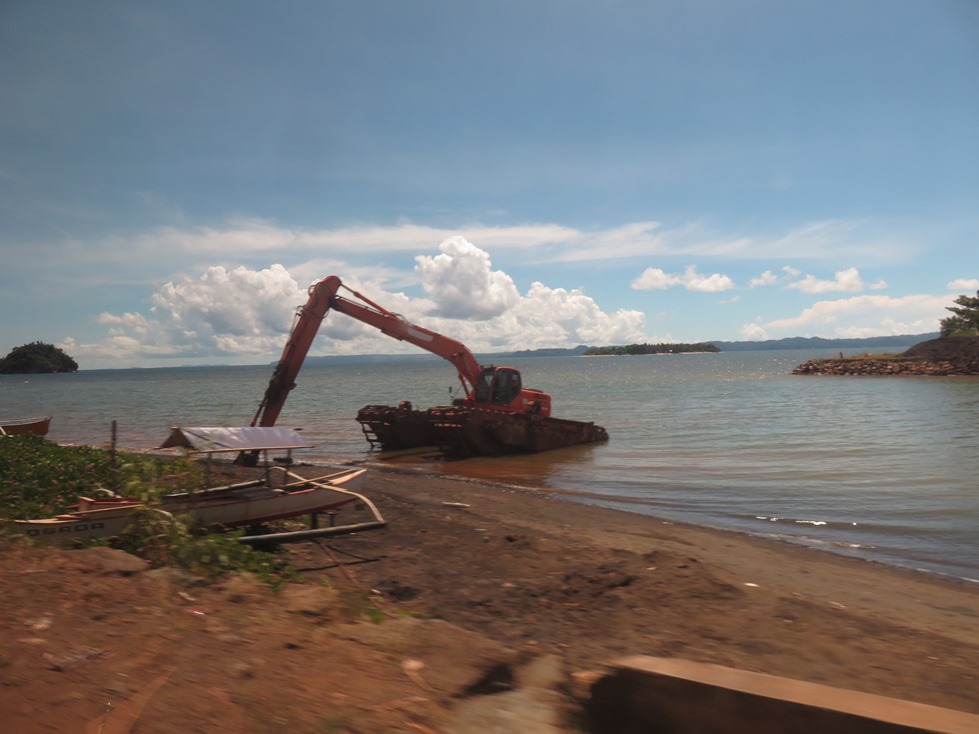
Left Photo: A chimney of the processing plants and Taganito nickel mining site (back) (May 2018)
Right Photo: Taganito River flowing from Taganito mining area. At the mouth of the river, dredging work was in process. (May 2018)
●Water Quality Analysis in Rio Tuba, Bataraza, Palawan(October 2018, March 2019)
The results of our water quality analysis for 11 years in Rio Tuba have proved that Cr (VI) in the Togpon River almost all the time in the rainy season exceeded the environmental standards in Japan, or “Environmental Quality Standards Concerning the Protection of the Human Health” (not exceeding 0.05 mg/L) (Refer to Table 2 below).
Table 2: The result of Water Quality Analysis in Togpon River on Cr (VI) for 11 years (Unit: mg/L)
(Remarks: The figures in boldface are the water samples which exceeded the environmental standards in Japan, or “Environmental Quality Standards Concerning the Protection of the Human Health” [not exceeding 0.05 mg/L])

(*) Examination by ICP-MS, or Inductively Coupled Plasma Mass Spectrometer, at the laboratory in Japan
(**) On-the-spot examination by simple detector tube for Cr (VI)
(***) It was impossible to examine this water sample immediately due to the reddish brown muddiness. The above data of Cr(VI) is the result of examination after a half day when the inclusion was settled. Likewise, the above data of total Cr is the result of examination after filtering.
At the time of our water quality analysis in the rainy season (October) of 2018, the river water flow was less than in the previous rainy season. Therefore, Cr (VI) was not detected very much. Having said that, Cr (VI) was higher than the dry season, which exceeded the standard (0.055 mg/ L) at the Togpon River. In addition, according to the results of the water quality analysis in the dry season (March) in 2019, Cr (Ⅵ) did not exceed the environmental standard in the Togpon River as it was in the previous dry season.
The expert pointed out the following issues with the results above (Refer to the document on the result for more details).
・It was reconfirmed that Cr (Ⅵ) was liquated mainly by rainfall in the mining and the processing plant areas.
・According to a Japanese company concerned, the project owners had started to take mitigation measures against Cr (VI) flowing out since 2012, such as covering the nickel ore stockpile with canvas sheets, excavating the siltation pond, and putting activated charcoal around the exit of siltation pond liking to Togpon River. No change, however, has been seen since 2012 in the tendency that Cr (VI) exceeds the Japanese environmental standards in the rainy season. It is highly questionable whether their anti-pollution measures are effective.
・From the viewpoint of preventing the damage to the local people’s health, the project companies, especially Sumitomo Metal Mining should accept the NGO's proposal for the joint investigation regarding the water quality, aiming at searching the pollution mechanism, so that they can develop the drastic anti-pollution measures. Immediate and wise decision by the project companies is expected.
・Sumitomo Metal Mining must take measures to rehabilitate the mangrove ecosystem in the Rio Tuba bay, which has been heavily destroyed due to the serious contamination, but not only taking measures to improve the water quality in the Togpon River.
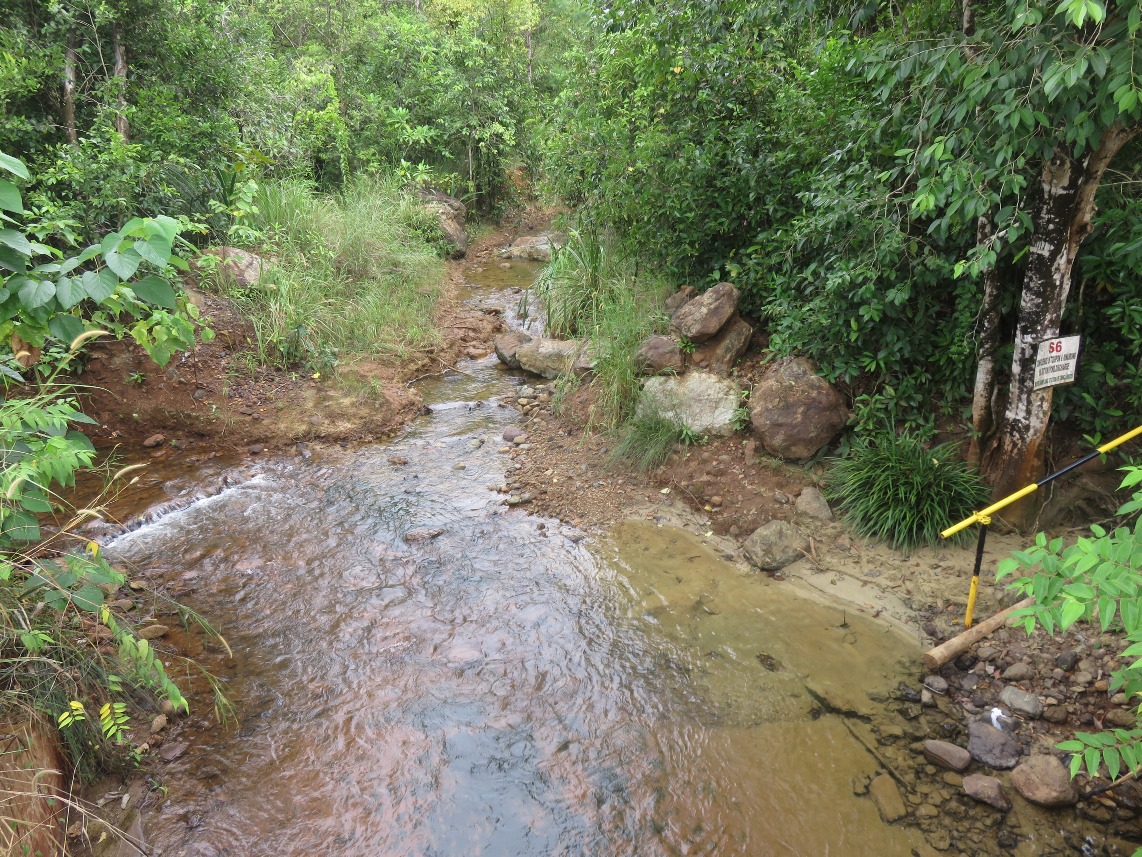
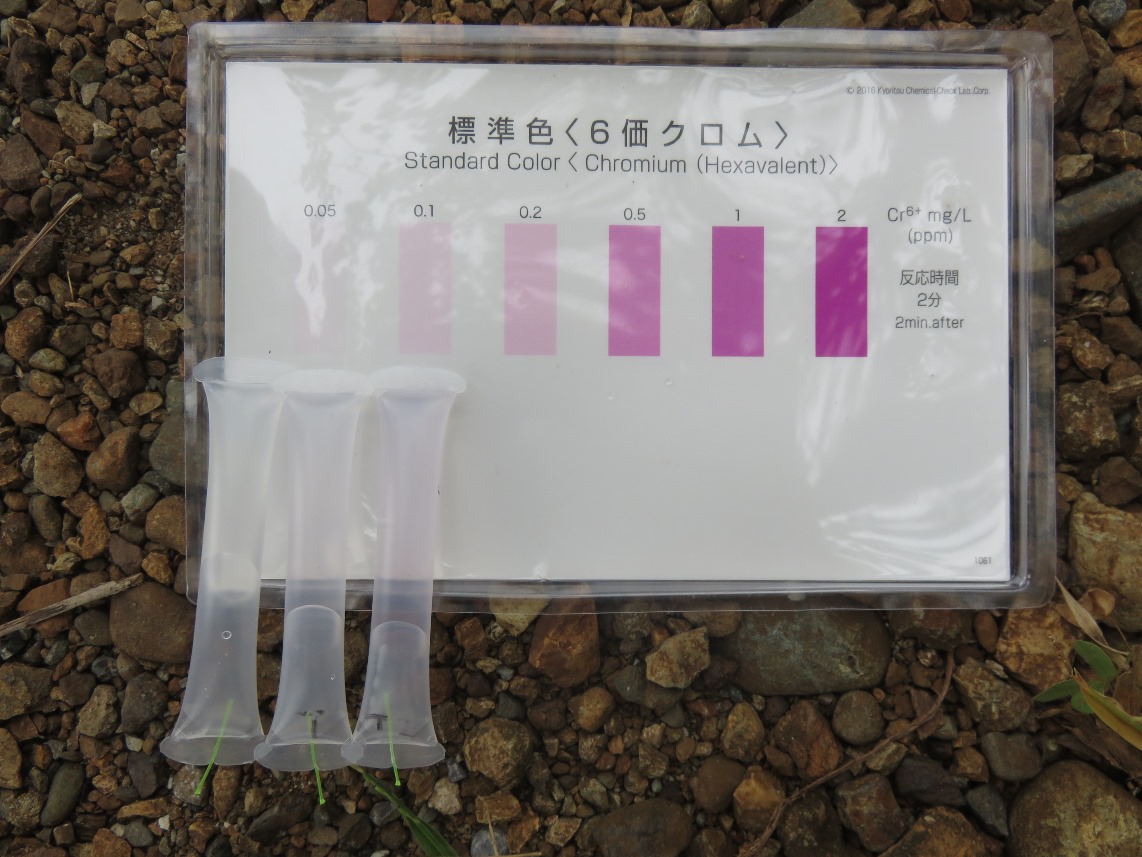
Left Photo: Togpon River
Right Photo: The result of examination by simple detector tube for hexavalent chromium (trace) (April 29, 2018)
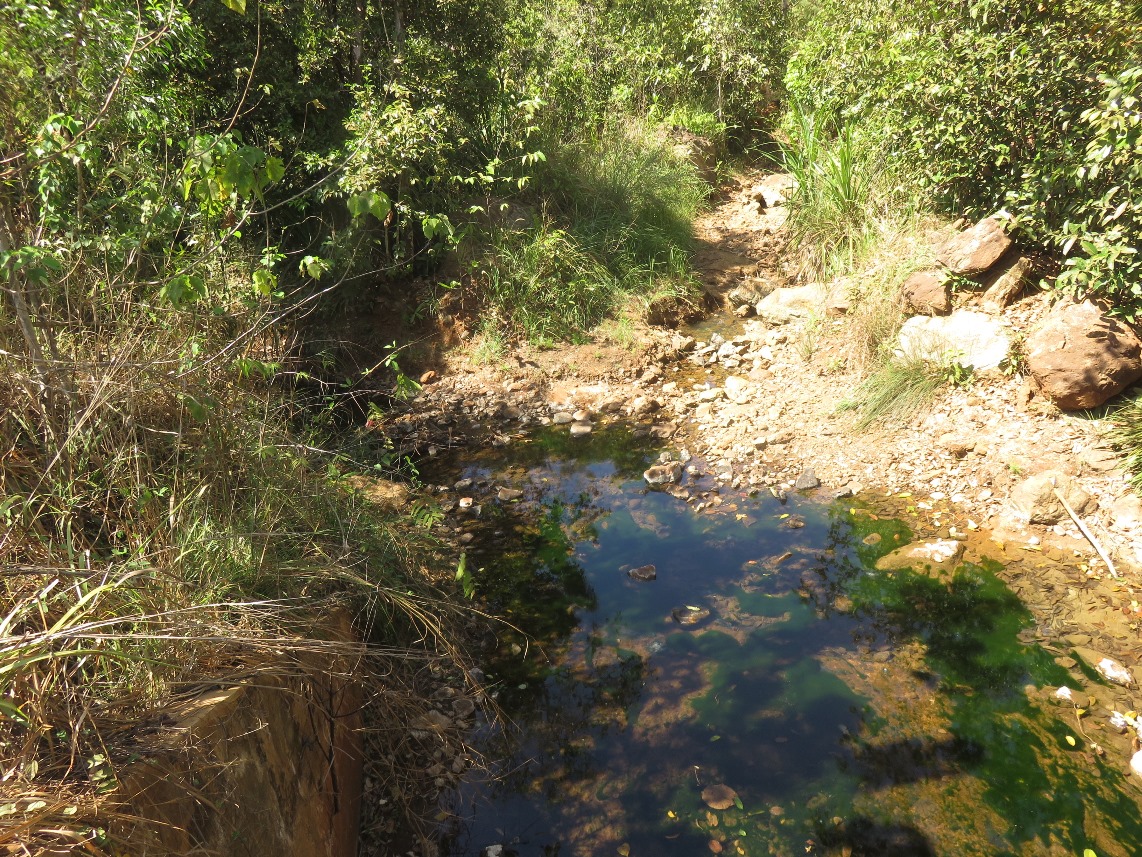
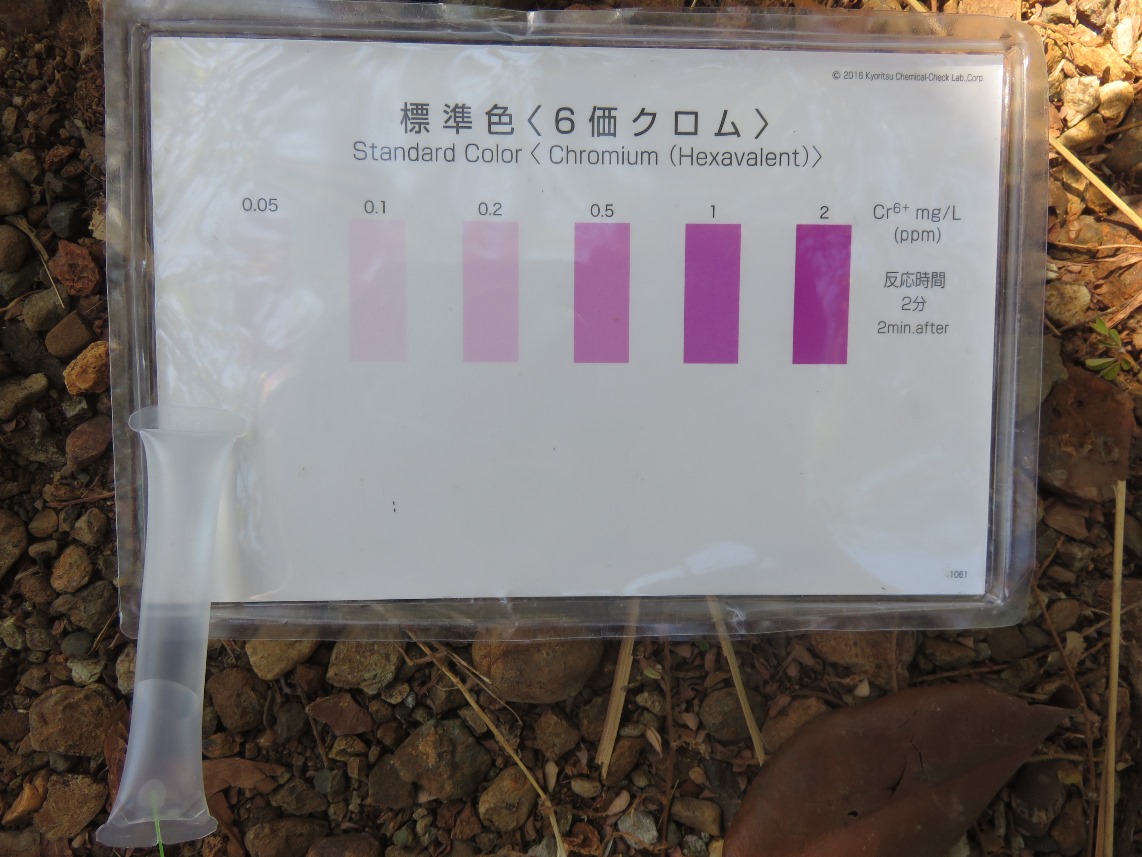
Left Photo: Togpon river (with green algae)
Right Photo: The result of simple detector tube for Cr (Ⅵ) (no detection) (March 22, 2019) All photos’ credit: FoE Japan
> Please see the detailed result and comments of the latest water analysis (in October 2018) by the expert at the following link;
- Map of Locations of Water Sampling in Palawan (October 2018)
> Please see the detailed result and comments of the latest water analysis (in March 2019) by the expert at the following link;
- Map of Locations of Water Sampling in Palawan (March 2019)
●Water Quality Analysis in Taganito, Claver, Surigao del Norte (December 2018)
Like the previous survey in May 2018, Cr (Ⅵ) (0.075~0.15 mg/L)exceeding the Japanese environmental standards(not exceeding 0.05mg/L)was continually detected in Taganito river and Hayanggabon river.
There was a spring near the resettlement site of Indigenous Mamanwa people who have been affected by Taganito mining. The spring was used for drinking water and domestic water by the Mamanwa people and residents living around. From the spring water, Cr(Ⅵ)exceeded the Japanese Environmental Standards and Japanese Water Supply Act (0.05mg/L). Also, nickel exceeded the Control Target under the Japanese Water Supply Act (0.01mg/L) in the spring water. Especially, approximately 0.6 mg/L of Cr (Ⅵ) was detected in the spring water.
The expert pointed out the following issues with the results above (Refer to the document on the result for more details).
・It was reconfirmed that serious contamination by Cr (VI) has been occurring in shallow underground water, which the local community is using for domestic and/or drinking purposes, in the whole area of Taganito, Surigao del Norte
・Given that the same kind of contamination has been proved in Rio Tuba, Palawan, the hypothesis could be build up that open-pit mining of laterite in the tropics would universally cause the contamination by Cr (VI).
・In any case, the appropriate measures must be established and implemented as quickly as possible in Palawan as well as Surigao del Norte, as there are concerns over the health damage of the local communities and the destruction of ecosystem in bays and coastal areas. If any appropriate measures could not be established, it should be taken into account to suspend or stop the projects.
In Taganito, not only Japanese company but also Chinese companies etc. have nickel minings, which leads serious Cr(Ⅵ) contaminations in many water resources in the same region. Japanese companies need to take immediate measures such as analyses of mechanism for Cr(Ⅵ) contaminations, research into environmental burdens, and establishing and practicing of antipollution measures, cooperating with other companies and local governments.
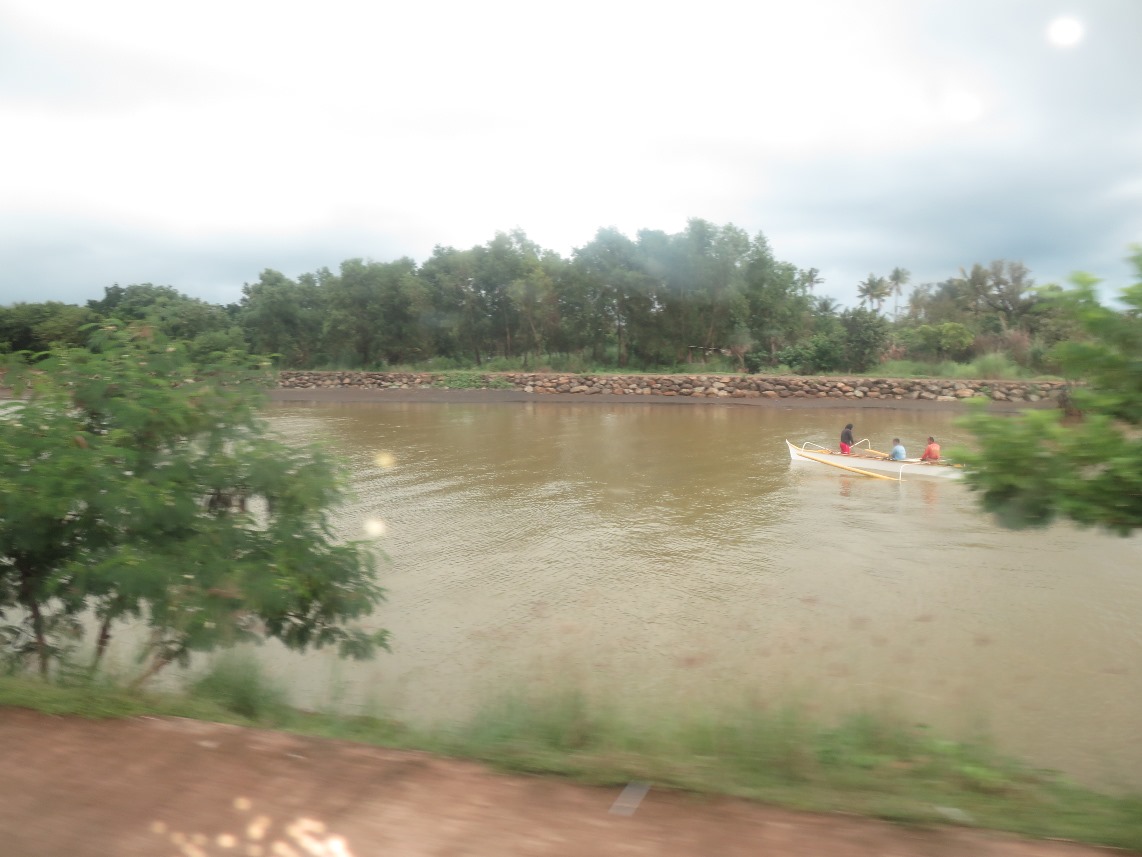
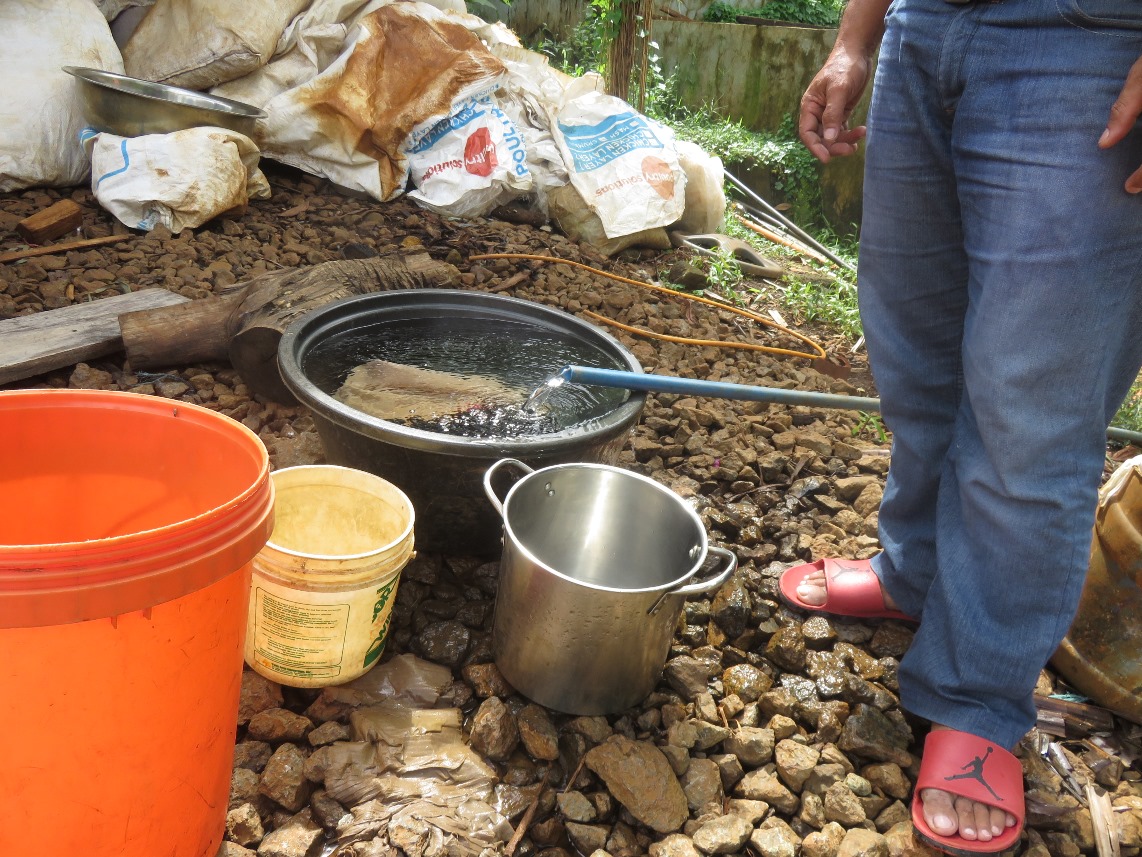
Left Photo: Taganito River and fishery operators
Right Photo: No. 5, the spring water for domestic use, which located on the left side down from the entrance of the resettlement site of the Indigenous Mamanwa (outside the resettlement site) (Brgy. Cagdianao).
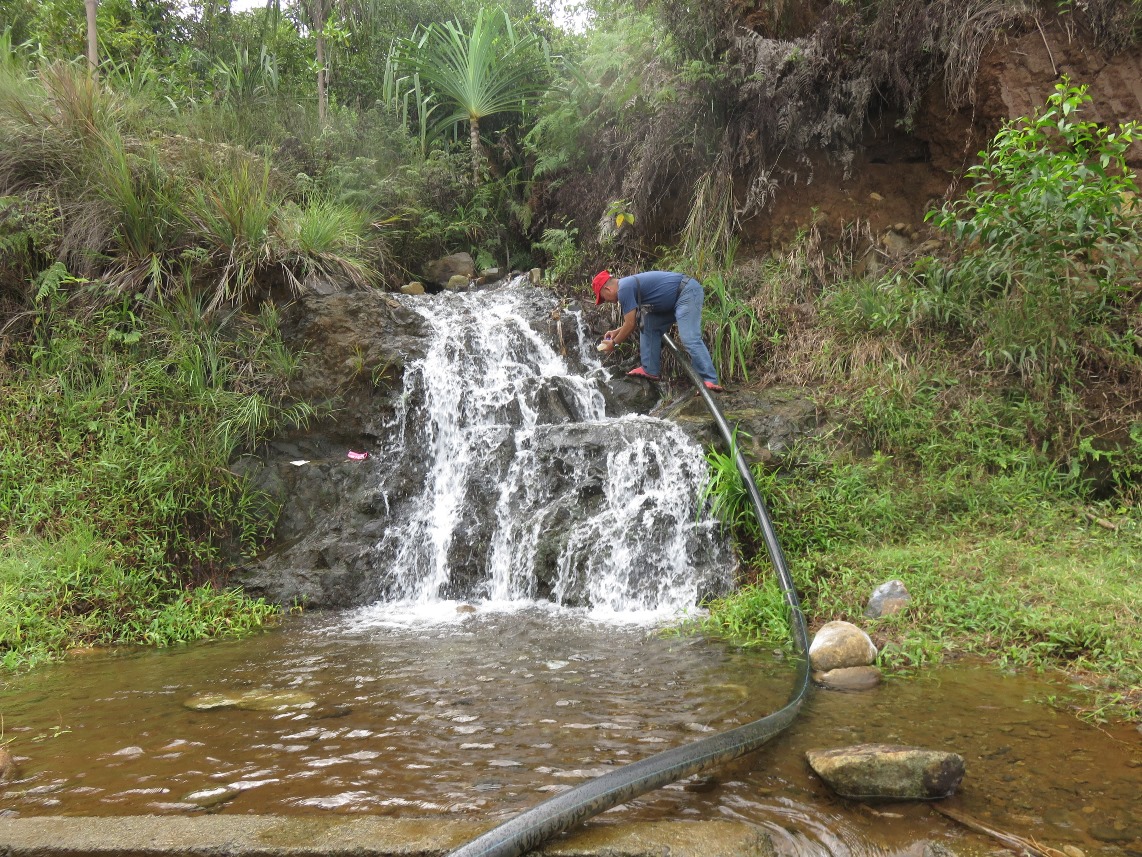
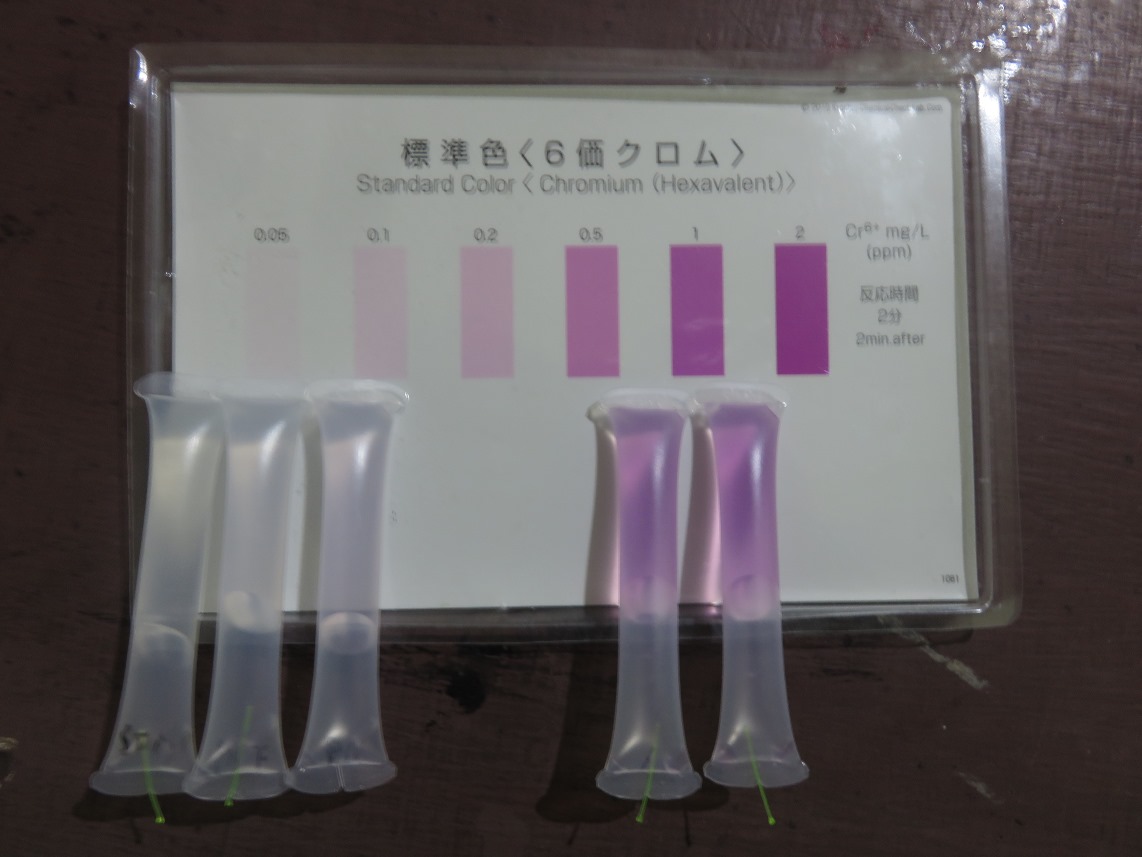
Left Photo: No.6, water for domestic use, located along the road near the entrance of the resettlement.
Right Photo: The results of simple detector tube for Cr (VI). From the left side, water from SDMP drinking water supply program (no detection), No.6 (0.04 mg/L), No.4 (0.08 mg/L), and No.5 (1.0mg/L, 2 samples)(December 13, 2018, photo: FoE Japan)
> Please see the detailed result and comments of the latest water analysis (in December 2018) by the expert at the following link;
- Map of Locations of Water Sampling in Surigao del Norte (December 2018)

